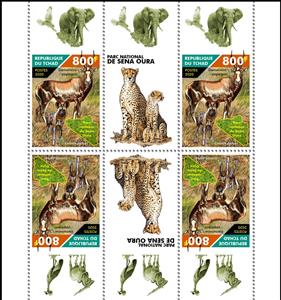Se-tenant: 10th Anniversary of the Sena Oura National Park (Chad 2020)
10th Anniversary of the Sena Oura National Park (Chad 2020)
30 November (Chad ) within release Sena Oura National Park (2020) goes into circulation Se-tenant 10th Anniversary of the Sena Oura National Park face value 4*800 Central African CFA franc
| Se-tenant 10th Anniversary of the Sena Oura National Park in catalogues | |
|---|---|
| Colnect codes: | Col: TD 2020-10MS01 |
Se-tenant is square format.
Stamps Se-tenant & Tete-Beche perforated on 3 sides. Although this edition is authorized by the Postal Administration of Chad, it was not sold in Chad, but only distributed to the novelty trade by the Philatelic Agency of Chad.Also in the issue Sena Oura National Park (2020):
- Mini Sheet - 10th Anniversary of the Sena Oura National Park face value 4*800;
- Souvenir Sheet - 10th Anniversary of the Sena Oura National Park face value 3,300;
- Se-tenant - 10th Anniversary of the Sena Oura National Park face value 4*800;
- Se-tenant - 10th Anniversary of the Sena Oura National Park face value 4*800;
- Se-tenant - 10th Anniversary of the Sena Oura National Park face value 4*800;
- Se-tenant - 10th Anniversary of the Sena Oura National Park face value 4*800;
- Stamp - Damaliscus pygargus - Lycaon pictus face value 800;
- Stamp - Damaliscus pygargus - Lycaon pictus face value 800;
- Stamp - Falco cherrug - Loxodonta africana face value 800;
- Stamp - Falco cherrug - Loxodonta africana face value 800;
- Stamp - Hippotragus niger - Acinonix jubatus face value 800;
- Stamp - Hippotragus niger - Acinonix jubatus face value 800;
- Stamp - Taurotragus derbianus - Balearica pavonina face value 800;
- Stamp - Taurotragus derbianus - Balearica pavonina face value 800;
Se-tenant 10th Anniversary of the Sena Oura National Park it reflects the thematic directions:
Animals are multicellular, eukaryotic organisms of the kingdom Animalia (also called Metazoa). All animals are motile, meaning they can move spontaneously and independently, at some point in their lives. Their body plan eventually becomes fixed as they develop, although some undergo a process of metamorphosis later on in their lives. All animals are heterotrophs: they must ingest other organisms or their products for sustenance.
The term antelope refers to numerous extant or recently extinct species of the ruminant artiodactyl family Bovidae that are indigenous to most of Africa, India, the Middle East, Central Asia, and a small area of Eastern Europe. Antelopes do not form a monophyletic group, as some antelopes are more closely related to other bovid groups, like bovines, goats, and sheep, than to other antelopes.
A better definition, also known as the "true antelopes", includes only the genera Gazella, Nanger, Eudorcas, and Antilope. One North American mammal, the pronghorn or "pronghorn antelope", is colloquially referred to as the "American antelope", despite the fact that it belongs to a completely different family (Antilocapridae) than the true Old-World antelopes; pronghorn are the sole extant member of an extinct prehistoric lineage that once included many unique species.
Mammals are any vertebrates within the class Mammalia (/məˈmeɪli.ə/ from Latin mamma "breast"), a clade of endothermic amniotes distinguished from reptiles (including birds) by the possession of a neocortex (a region of the brain), hair, three middle ear bones and mammary glands. All female mammals nurse their young with milk, secreted from the mammary glands. Mammals include the largest animals on the planet, the great whales. The basic body type is a terrestrial quadruped, but some mammals are adapted for life at sea, in the air, in trees, underground or on two legs. The largest group of mammals, the placentals, have a placenta, which enables the feeding of the fetus during gestation. Mammals range in size from the 30–40 mm (1.2–1.6 in) bumblebee bat to the 30-meter (98 ft) blue whale. With the exception of the five species of monotreme (egg-laying mammals), all modern mammals give birth to live young. Most mammals, including the six most species-rich orders, belong to the placental group. The largest orders are the rodents, bats and Soricomorpha (shrews and allies). The next three biggest orders, depending on the biological classification scheme used, are the Primates (apes and monkeys), the Cetartiodactyla (whales and even-toed ungulates), and the Carnivora (cats, dogs, seals, and allies).



